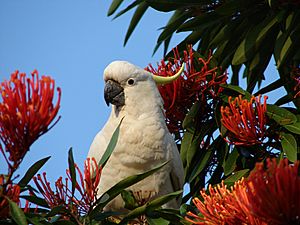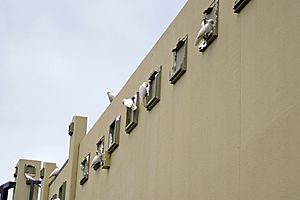Sulphur-crested cockatoo facts for kids
Quick facts for kids Sulphur-crested cockatoo |
|
|---|---|
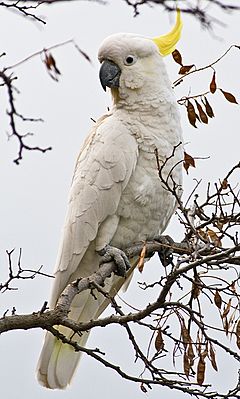 |
|
| C. galerita in Tasmania, Australia | |
| Conservation status | |
| Scientific classification | |
| Kingdom: | |
| Phylum: | |
| Class: | |
| Order: | |
| Family: | |
| Subfamily: |
Cacatuinae
|
| Genus: |
Cacatua
|
| Binomial name | |
| Cacatua galerita |
|
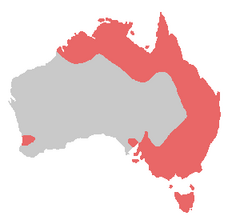 |
|
| Australian sulphur-crested cockatoo range (in red) | |
Sulphur-crested cockatoos are large white parrots. They have bright yellow crests on their heads and yellow feathers under their wings and tails. These birds are known for being very smart and curious.
There are four main types, or subspecies, of the sulphur-crested cockatoo. They mostly live in Australian forests and also in New Guinea. Many people enjoy these birds and keep them as pets. They are very loud and love to chew on wood and other things. Sulphur-crested cockatoos can live for a very long time. Some have even lived for over 70 years!
Contents
Where Sulphur-crested Cockatoos Live
Sulphur-crested cockatoos are found in many parts of Australia. They live in the north and east, from a place called the Kimberley all the way down to Tasmania. However, they usually avoid dry areas with few trees.
You can often see them in cities like Adelaide, Melbourne, Canberra, Sydney, and Brisbane. They also live throughout most of New Guinea and on nearby islands.
Different Types of Sulphur-crested Cockatoos
There are four types of sulphur-crested cockatoos. Each type lives in a slightly different area:
| Image | Scientific Name | Common Name | Where They Live |
|---|---|---|---|
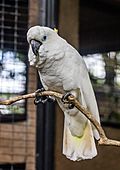 |
C. g. triton | Triton cockatoo | Found in New Guinea and its surrounding islands. |
 |
C. g. eleonora | Eleonora cockatoo | Lives only on the Aru Islands in eastern Indonesia. |
 |
C. g. fitzroyi | Mathews cockatoo | Found in northern Australia, from Western Australia to the Gulf of Carpentaria. |
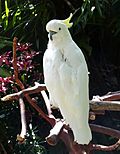 |
C. g. galerita | Greater sulphur-crested cockatoo | Lives from Cape York down to Tasmania. |
Cockatoos in New Places
Sulphur-crested cockatoos have also been brought to other places by people. For example, they were introduced to Perth in Australia, which is outside their natural home. Outside Australia, they now live in Singapore, Palau, and New Zealand.
What Sulphur-crested Cockatoos Look Like
These birds are usually between 44 and 55 centimeters (about 17 to 22 inches) long. The ones from Australia are generally bigger than those from New Guinea. Their body feathers are mostly white.
They have a bright yellow crest on their head that they can raise or lower. Their beak is black, their legs are grey, and they have a whitish ring around their eyes. It's hard to tell males and females apart, but males usually have very dark eyes, while females have more reddish-brown eyes.
Sulphur-crested cockatoos look a bit like corellas, another type of Australian bird. But corellas are smaller, don't have such a big yellow crest, and have lighter-colored beaks.
Cockatoo Behavior and Life

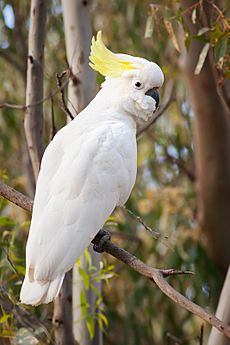
Sulphur-crested cockatoos make very loud, squawking calls. These calls are designed to travel far through the dense forest environments where they live. They are very curious and smart birds. They have learned to live well in cities and towns in Australia.
These birds are known for living a long time. In the wild, they might live for 20 to 40 years. But in captivity, they can live much longer, sometimes over 70 years. One famous cockatoo named Fred was still alive at 100 years old in 2014!
They sometimes eat clay, which helps them get rid of toxins from their food. Instead of using oil to waterproof their feathers like many birds, cockatoos produce a very fine powder.
Reproduction and Life Cycle
In Australia, sulphur-crested cockatoos breed during certain seasons. In southern Australia, it's from August to January. In northern Australia, it's from May to September. Not much is known about their breeding in New Guinea.
They build their nests in hollows inside trees, using wood chips as a bed. They often compete with other birds for the best nesting spots. A female cockatoo usually lays two to three eggs. Both parents take turns sitting on the eggs for about 25 to 27 days until they hatch.
After the chicks hatch, both parents feed and care for them. The young birds stay in the nest for about 9 to 12 weeks. Even after they learn to fly, they stay with their parents for several months.
Smart Birds
A study in 2009 looked at an Eleonora cockatoo named Snowball. The study found that sulphur-crested cockatoos can move their bodies in time with music! This shows how intelligent they are.
When a group of cockatoos is on the ground, they are more open to predators. To stay safe, at least one cockatoo will sit high up in a tree, acting as a lookout. This behavior is so well-known in Australia that a person keeping watch for something, like police, is sometimes called a "cockatoo" or "cocky."
Cockatoos and People
In some parts of Australia, there are so many sulphur-crested cockatoos that they can cause problems. They might eat cereal and fruit crops, damage newly planted trees, or chew on wooden parts of houses and outdoor furniture.
Because of this, farmers sometimes try to get rid of them. However, sulphur-crested cockatoos are a protected species under Australian law. This means you need a special permit to harm them.
Cockatoos as Pets
Sulphur-crested cockatoos are popular pets, but they are a big responsibility. They need a lot of attention and love to chew on things. They can also be very loud, making piercing screeches. They might also make sudden, energetic movements, which can surprise people.
These birds can get a viral illness called psittacine beak and feather disease. This disease makes birds lose their feathers and can cause their beaks to grow in strange shapes. It can affect cockatoos both in the wild and in captivity.
See also
 In Spanish: Cacatúa de moño amarillo para niños
In Spanish: Cacatúa de moño amarillo para niños



